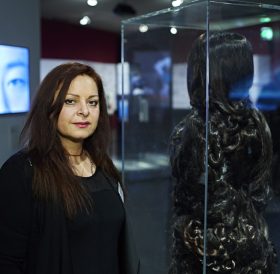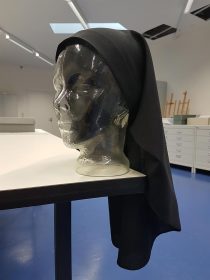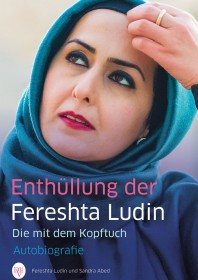Of Persian fairy tales and female self-determination

Artist Mandana Moghaddam standing next to her sculpture Chelgis I in the exhibition Cherchez la femme. Wig, Burqa, Wimple; Jewish Museum Berlin, photo: Yves Sucksdorff
In the course of the new exhibition Cherchez la femme – which deals with the covering of women within the idea of the monotheism of the three leading religions – we spoke with Iranian artist Mandana Moghaddam. Her artwork Chelgis (pronounced “Gelgis”) contributes to the concept of the exhibition in an impressive way and further stimulates the viewers’ own contemplation on the subject. Just in time for the exhibition’s opening we conducted a short interview with Mandana Moghaddam:
Dear Ms. Moghaddam, would you tell us a little bit about your artwork and the story of Chelgis?
I began my work by thinking of contemporary womens’ issues, examining them from different angles. When I drew the first sketch I saw the story of Chelgis – which means “40 braids” – right in front of me. → continue reading
A Visit with Sister Katharina at Karmel Berlin

Sister Katharina donated this veil to us for our exhibition; Jewish Museum Berlin, photo: Katharina Erbe.
Covering one’s head has almost entirely disappeared from Christian women’s devotional practice. In Germany, you only actually see veils on the sisters of Catholic religious orders. In preparing for the exhibition Cherchez la femme (more about it on our website) we all agreed early on that we wanted a nun’s veil.
So I set out for Karmel Regina Martyrum in the northern part of Berlin’s Charlottenburg district, a convent of Discalced (or Barefoot) Carmelites. The convent’s wardrobe mistress, Sister Katharina, greeted me at the door. After some discussion, her view on the matter emerged as fairly sober: some people may ascribe specific spiritual meaning to certain items of clothing but it was very personal issue. In any one community you can meet with a wide variety of attitudes and practices.
Our conversation about the meaning of their religious dress began with Sister Katharina sharing an anecdote: → continue reading
A Conversation with Fereshta Ludin about the Headscarf Debate, Discrimination, and Her Hopes for the Future.
To win the right to work as a teacher in the classroom while wearing her headscarf, Fereshta Ludin had to go all the way to the German Supreme Court (see below). On 17 September 2015, she will join us as part of the series “New German Stories” to introduce her book Enthüllung der Fereshta Ludin. Die mit dem Kopftuch (“The Unveiling of Fereshta Ludin: The One with the Headscarf”). Rafiqa Younes and Julia Jürgens spoke with her in the lead-up to the event.

Book cover © Deutscher Levante Verlag
Ms. Ludin, did you ever guess that the first lawsuit you filed against your employers, in 1998 when you were 25 years old, would set off a nationwide debate about the headscarf ban?
You can’t really imagine something like that. I was still very young and idealistic. I wanted to work as a teacher and had no intention of provoking the public or any politicians.
From your perspective, was it worth it to go all that way through courts, becoming, as you did, a public figure – “the one with the headscarf” as the title of your book ironically references?
I don’t regret a single step along the way. I would have regretted much more, to have had to endure the injustice. I took an active stand against discrimination by going through the courts. Many other women were also affected. It was never my aim to become a public person. → continue reading


